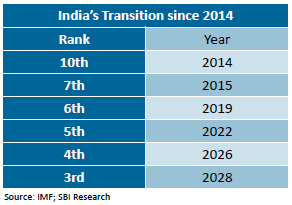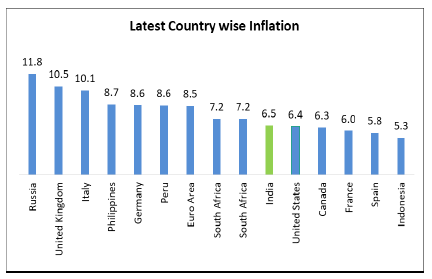Listen to this article
India is adding 1 trillion dollars every three years and in terms of the nominal GDP, it climbed up from the 10th position in 2014 to the 5th position in 2022. Going by these trends, India is poised to become a 5 trillion-dollar economy by FY 2028.
But how will the Indian economy look like when it reaches the 5 trillion-dollar mark?
To get a sneak peep into the 5 trillion-dollar economy, Cafemutual Ideas Fest 2023 (CIF 23) hosted Soumya Kanti Ghosh, Group Chief Economic Advisor, SBI who shared some attention-grabbing numbers.
Here are the key highlights.
India is likely to be the third largest economy by FY 2028 - From being the tenth largest economy in FY 2014, India is likely to grow into the world’s third largest economy in FY 2028. The plus one strategy and ease of doing business along with enhanced competitive/innovation index ranking and infrastructure push will alter the business landscape.

Big banks to continue to be pivotal - In FY 2022, private banks generated Rs. 96,223 crore of net profits and had a 34% asset share. However, though public sector banks’ asset share was higher at 58%, the net profit stood at Rs. 66,540 crore.
Though small finance banks and private banks will play a key role in financial inclusion, their narrow business models make them weak. On the other hand, big banks will continue to thrive through business expansion.
Growth and inflation trends - For the last three years, the Indian economy has been the fastest growing economy at 8.7%, 6.8% and 6.1% respectively. This year RBI forecasts growth at 6.4%. Also, if the receding commodity prices stay at low levels, it will be positive for the growth of the economy.

At 6.5% India’s inflation is almost similar to other countries and is likely to trail lower in the next two months and could be closer to 5% by April.
Other indicators - The GST collection has constantly been Rs. 1.50 lakh crore. Also, the UPI transactions value today is Rs. 113 lakh crore and at this rate, it is going to be 48% of India’s GDP by the end of March 2023. Today the incremental currency circulation is little more than Rs. 1 lakh crore, so the ratio of UPI transactions to currency circulation is 113:1. This shows some phenomenal work in the UPI transactions.
Also, the fortnightly ASCB (All Scheduled Commercial Banks) credit growth is at its peak. And, the FDI flow has been constantly growing and this year it could be closer to 85 dollar billion, despite the era of global uncertainties.
Further, the 36 million demat accounts opened from April 2020 to November 2022 show the behavioural change in savings since the pandemic. This is positive for the financialization of savings through equity, mutual funds, etc.






